Perhaps no term in food science has gained a worse reputation than the word fat. Just the mere mention of the word can bring shivers to the spines of nutritionists and consumers everywhere. However, it is important to remember that fats are an essential part of a proper diet and an important constituent in many types of food products. Lipids are the primary source of the fat-soluble vitamins A, D, E and K and are a concentrated source of energy providing over twice the energy of carbohydrates or protein. In addition, fats and oils add function, taste and palatability to many types of foods. However, the consumption of specific lipids and their potential impact on health remains an extremely important dietary issue.
Although the exact origins of the terms fats and lipids in connection with a chemical component of foods is unclear, both words can be traced to ancient times. The word lipid is derived from the Greek "lipos," meaning fat. The Old English word "faett," appeared in the classic ninth century tale of Beowulf and was used to describe vessels or vats of large size. Through the decades, the term found its way into the popular lexicon and the meaning expanded. A popular proverb of the 1600s declared that "Every Fatt must stand on his own bottom." In the 1860s, the term fatt was used in some references as a measure equal to approximately nine gallons. Over the years, the terms fat and lipid have been used interchangeably to describe a group of chemical compounds including triacylglycerol (i.e., triglycerides), phospholipids, and sterols. Fatty acids are so named due to their role as the key components of lipids and their structure which contains an organic acid group (i.e., COOH).
Fast Facts on Fat
Lipids are present in, and derived from, both plant and animal sources. The primary constituents of these fats are triglycerides which account for about 90% of the fats in food and over 90% of the fat in the body. Other minor components include sterols, and mono- and diglycerides. Plant sterols include campesterol, stigmasterol and ß-sitosterol. Cholesterol is found almost exclusively in animal fats.
Although these substances are often unrelated physiologically and chemically, their classification is based upon their solubility in nonpolar solvents (e.g., chloroform, benzene, ether, alcohol). Structurally, triglycerides consist of fatty acids which are a linear chain of atoms, with one end composed of a carboxyl group and the other end being a methyl group. The chemical structure of lipids is extremely important in their classification and properties. The number of carbon and hydrogen atoms as well as number and position of double bonds determine the physical characteristics and metabolic properties of the fat.
Fatty acids are the building blocks of lipids and comprise 85%-95% of the fats in foods. It is these compounds that are of interest when reporting the lipid content of foods for nutrition labeling. Fatty acids are given a numeric classification. The first number is the length of the carbon chain and the second number represents the number of double bonds found in the chain. For example, linoleic acid is comprised of 18 atoms and two double bonds resulting in a chemical classification of 18:2. Short chain fatty acids are generally defined as having a carbon chain length of up to four. Medium chain have 6-12 and long chain have a chain length greater than 12. It is the chemical structure of these fatty acids that is a key to the physiological effects of the triglyceride.
Saturation and Isomers
Saturated fatty acids are hydrocarbon chains with only single bonds between each of the carbon atoms. Saturated fatty acids tend to raise levels of low-density lipoproteins (LDL)-cholesterol in the blood. Saturated fatty acids are primarily found in animal products such as meat and dairy products. Some tropical oils, such as palm and coconut also contain saturated fatty acids.
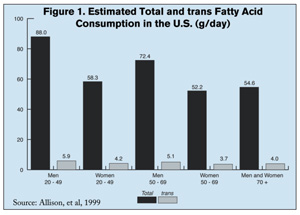 Unsaturated fatty acids are characterized by one or more double bonds in the carbon chain. The greater the degree of unsaturation, the softer the fat. Unsaturated fatty acids (e.g., omega-3 fatty acids) are also highly reactive with oxygen. A monounsaturated fatty acid has one double bond in the carbon chain. Monounsaturated fatty acids are found mostly in plant and seafoods. Olive oil is a good source of monounsaturated fatty acids. Monounsaturated fatty acids tend to lower levels of LDL-cholesterol in the blood. Polyunsaturated fatty acids have more than one double bond. Polyunsaturated fatty acids are primarily found in plant and sea foods. Safflower and corn oils are high in polyunsaturated fatty acids. Polyunsaturated fatty acids are thought to lower levels of both LDL- and high-density lipoproteins (HDL) cholesterol in the blood.
Unsaturated fatty acids are characterized by one or more double bonds in the carbon chain. The greater the degree of unsaturation, the softer the fat. Unsaturated fatty acids (e.g., omega-3 fatty acids) are also highly reactive with oxygen. A monounsaturated fatty acid has one double bond in the carbon chain. Monounsaturated fatty acids are found mostly in plant and seafoods. Olive oil is a good source of monounsaturated fatty acids. Monounsaturated fatty acids tend to lower levels of LDL-cholesterol in the blood. Polyunsaturated fatty acids have more than one double bond. Polyunsaturated fatty acids are primarily found in plant and sea foods. Safflower and corn oils are high in polyunsaturated fatty acids. Polyunsaturated fatty acids are thought to lower levels of both LDL- and high-density lipoproteins (HDL) cholesterol in the blood.
Isomers of fatty acids contain the identical numbers of carbon, hydrogen, and oxygen atoms, but the atoms or bonds differ in positional or geometric arrangement. Positional isomerism is related to the position of the double bond or bonds along the carbon chain. Geometric isomerism is based upon the arrangement of the hydrogen atoms in relation to two carbon atoms connected by a double bond. Hydrogen atoms attached to the carbons on the same side of the molecule are cis isomers. Most naturally occurring fatty acids are cis-isomers, and are the type best utilized by humans. In a "trans" (Latin for across) configuration, the hydrogen atoms attached to the carbon atoms at a double bond are on opposite sides of the molecule. This arrangement of hydrogen atoms stabilizes the molecule in a relatively straight contour. Trans fatty acids are thought to raise the levels of LDL cholesterol in the blood thereby increasing the risk of heart disease.
The Transfixion on Trans
Although there are some naturally occurring trans isomer fatty acids, the majority are polyunsaturated fatty acids in which hydrogen atoms are added using a chemical process called hydrogenation. In this process hydrogen atoms are added to unsaturated sites on the carbon chains of fatty acids in the presence of catalysts, thereby reducing the number of double bonds. "Partial hydrogenation" is an incomplete saturation of the double bonds, in which some double bonds remain but may be moved in their positions on the carbon chain and changed from a cis to trans configuration. This results in "straighter" fatty acids that solidify at higher temperatures. In foods, the trans fatty acid isomer most commonly encountered is monounsaturated trans-C18:1. However, mono-C16:1 and polyunsaturated-18.2 are also found.
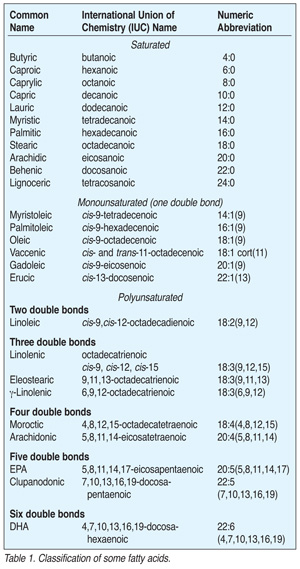 The partial hydrogenation process was developed in the 1930s and has been in commercial use since the 1940s. The process improves the oxidative and thermal stability by adding hydrogen to the double bonds. This increases the melting point, shelf life, and flavor stability of unsaturated fatty acids. As a result, oils such as soybean, safflower and cottonseed, which are rich in unsaturated fatty acids, are converted to semi-solids and solids that are useful in margarines and vegetable shortenings. Hydrogenation also occurs in the digestive tract of ruminant animals and results in some trans isomers in the fat components of dairy and meat products from these animals. These isomers make up only a small percent of the total fatty acids.
The partial hydrogenation process was developed in the 1930s and has been in commercial use since the 1940s. The process improves the oxidative and thermal stability by adding hydrogen to the double bonds. This increases the melting point, shelf life, and flavor stability of unsaturated fatty acids. As a result, oils such as soybean, safflower and cottonseed, which are rich in unsaturated fatty acids, are converted to semi-solids and solids that are useful in margarines and vegetable shortenings. Hydrogenation also occurs in the digestive tract of ruminant animals and results in some trans isomers in the fat components of dairy and meat products from these animals. These isomers make up only a small percent of the total fatty acids.
While trans fatty acids are most commonly found in processed foods containing hydrogenated or partially hydrogenated vegetable oils, trans fat can be found in numerous foods ranging from dairy products to meats. Hydrogenated fats are components of many processed foods and bakery items, including pastries, biscuits and commercially fried foods.
Dietary fats containing hydrogenated fatty acids, such as those used in margarine, have gradually displaced animal fats, such as butter and lard. About two-thirds of the dietary fat consumed in the 1940s was of animal origin. The balance was reversed by the 1960s, with two-thirds coming from fats of vegetable origin. This trend resulted in a decrease in the intake of saturated fat and an increase in the intake of polyunsaturated and trans fatty acids.
The Good, the Bad and the Cholesterol
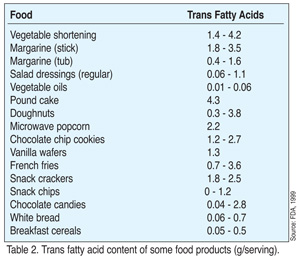 Diets high in fat are thought to increase the risk of some types of cancer (e.g., breast, colon, prostate) and the risk of coronary heart disease (CHD). Cholesterol and lipids combine with proteins to form lipoproteins. Lipoproteins are divided into four classifications: chylomicrons, LDL, HDL and very-low density lipoproteins (VLDL). Each of these have a different effect on serum cholesterol levels in the body. A high concentration of LDLs has been identified as a positive risk factor for heart disease. On the other hand, HDLs are thought to lower the risk of heart disease caused by atherosclerosis.
Diets high in fat are thought to increase the risk of some types of cancer (e.g., breast, colon, prostate) and the risk of coronary heart disease (CHD). Cholesterol and lipids combine with proteins to form lipoproteins. Lipoproteins are divided into four classifications: chylomicrons, LDL, HDL and very-low density lipoproteins (VLDL). Each of these have a different effect on serum cholesterol levels in the body. A high concentration of LDLs has been identified as a positive risk factor for heart disease. On the other hand, HDLs are thought to lower the risk of heart disease caused by atherosclerosis.
In spite of the negative publicity, it must be recognized that cholesterol is an essential component of the body. The average human's body contains between 150-200 mg/dl of cholesterol and will metabolize between 600-3,000 mg per day. Cholesterol is stored in the brain, nerve tissue and liver where it is synthesized into bile acids for digestion and absorption of fat soluble vitamins. Cholesterol also is a component of cell membranes and used in the synthesis of enzymes. The body regulates the cholesterol concentration in tissues and if more cholesterol is ingested, the natural synthesis will be reduced.
For many years, experts have advised replacing saturated fats in the diet with unsaturated fats. Originally the main emphasis was on the linoleic acid family (i.e., omega-6) that is derived primarily from vegetable sources. In recent years, attention has also focused on the omega-3 family, which is derived primarily from marine oils.
Fishing for an Answer
Attention to omega-3 fatty acids and their affect on health first came to light based on research that showed populations whose diet includes large amounts of fish lipids but small amounts of vegetables, fruit and grain had low incidences of heart disease. It was determined that their diet, although high in overall fat, contained a large percentage of both mono- and polyunsaturated fats. Research subsequently identified the omega-3 fatty acids eicosapentaenoic acid (EPA) and docosahexaenoic acid (DHA) as primary compounds of interest.
The omega-3 notation indicates the location of the first double bond in the chain. The closer the double bond is to the methyl group, the more effectively it is metabolized by humans. Research on omega-3 fatty acids has focused on their potential to interfere with blood clotting by lessening the ability of platelets to stick together. Omega-3s may also compete with arachidonic acid that aids in the development of thromboxane, which promotes clotting. In 2000, the FDA approved a qualified health claim for EPA and DHA in dietary supplements and their potential for reducing the risk of heart disease.
Recognizing and Regulating Health Claims
In recent years, several regulatory initiatives have had an effect on the amount of lipid information on product labeling as well as the potential use of health claims. The Nutrition Labeling and Education Act specifies that total fat, saturated fats and amount of cholesterol must be listed on the label. The amount of mono- and polyunsaturated fats may be voluntarily included. Health claims related to fats are strictly regulated and must be initiated by a government-sponsored scientific body based on scientific review. The FDA has approved the use of three health claims and is currently considering a fourth.
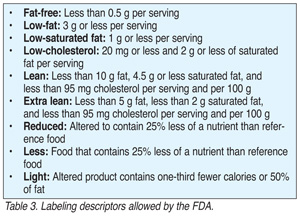 The agency has recognized that there is a relationship between dietary fat and cancer. Foods that meet the criteria for low descriptor labeling may include a phrase that states that a diet low in saturated fats may reduce the risk of some cancers. In addition, the FDA allows a link between dietary saturated fat and cholesterol and risk of coronary heart disease. Product labels meeting the requirements may be labeled "while many factors affect heart disease, diets low in saturated fat and cholesterol may reduce the risk of this disease." Claims may not mention specific types of fats and must use the terms "total fat" or "fat" and "some types of cancer" or "some cancers."
The agency has recognized that there is a relationship between dietary fat and cancer. Foods that meet the criteria for low descriptor labeling may include a phrase that states that a diet low in saturated fats may reduce the risk of some cancers. In addition, the FDA allows a link between dietary saturated fat and cholesterol and risk of coronary heart disease. Product labels meeting the requirements may be labeled "while many factors affect heart disease, diets low in saturated fat and cholesterol may reduce the risk of this disease." Claims may not mention specific types of fats and must use the terms "total fat" or "fat" and "some types of cancer" or "some cancers."
The FDA decided to allow the use of the qualified claim for omega-3 fatty acids despite the agency's determination that it did not meet the "significant scientific agreement" standard established for such claims. The specific language allowed is somewhat noncommittal. The approved claim states: "The scientific evidence about whether omega-3 fatty acids may reduce the risk of coronary heart disease is suggestive, but not conclusive. Studies in the general population have looked at diets containing fish and it is not known whether diets of omega-3 fatty acids in fish may have a possible effect on a reduced risk of CHD. It is not known what effect omega-3 fatty acids may or may not have on risk of CHD in the general population."
The amount of trans fatty acids in foods has been a consumer and regulatory concern since the adoption of the Nutrition Labeling and Education Act (NLEA). Although the NLEA required levels of saturated fat in foods to be reported on nutrition labels, it was felt that insufficient scientific information was available to require the inclusion of trans fat. However, this changed in July 2003 when the FDA amended the labeling regulations and required inclusion of trans fat on the labels of most food products and dietary supplements. The rule, first proposed in 1999, requires foods and dietary supplements that contain 0.5 g or more of trans fatty acids per serving to disclose the amount of these substances on the nutrition label. Processors have until January 2006 to comply.
Enactment of the regulations represents the FDA's acknowledgment that, like saturated fat and cholesterol, scientific evidence conclusively indicates that the consumption of trans fat raises levels of low density lipoprotein, thereby increasing the risk of coronary heart disease. This final rule requires manufacturers of conventional foods and some dietary supplements to list trans fat on a separate line, immediately under saturated fat on the nutrition or supplement facts label. The agency cites energy and nutrition bars as examples of dietary supplements that may require labeling.
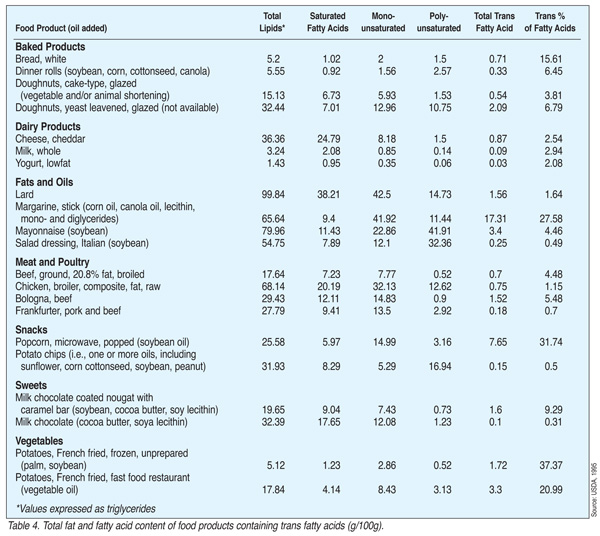 Products that contain less than 0.5 g of trans fat may list the level as 0 (zero) on the Nutrition Facts panel. However, the rules do not include any provisions for content claims such as "low" or "free", which are permitted for saturated fat and cholesterol. This is due to the fact that the National Academy of Science has been unable to determine a reference value (i.e., % daily value) based on their belief that no level of processed fat is considered safe. In addition, under the agency's definition, conjugated linoleic acid would be excluded from the definition of trans fat.
Products that contain less than 0.5 g of trans fat may list the level as 0 (zero) on the Nutrition Facts panel. However, the rules do not include any provisions for content claims such as "low" or "free", which are permitted for saturated fat and cholesterol. This is due to the fact that the National Academy of Science has been unable to determine a reference value (i.e., % daily value) based on their belief that no level of processed fat is considered safe. In addition, under the agency's definition, conjugated linoleic acid would be excluded from the definition of trans fat.
Under the final rule, dietary supplement manufacturers are required to declare trans fat on nutrition labels if the product contains "reportable amounts" (0.5 g or more) of trans fat per serving. Examples of dietary supplements that may be affected by this rule are "energy" and nutrition bars. Food manufacturers are required to declare the trans fat content on a separate line on the label.
Lipid Analysis
The analysis of food products for fats has evolved from the basic Babcock test developed in 1920 for the volumetric determination of total fat in whole milk to techniques utilizing sophisticated chromatographic methods. Because of the increased emphasis on the types of fat consumed, the analysis of foods involves measuring not only the amount of fat, but the levels of individual fatty acids. The key to accurate and complete lipid analysis of food products is the extraction process. Depending on the sample, one of several different extraction methods may be used including chloroform-methanol, ether, acid hydrolysis or an alkaline treatment. Matrix factors that have a significant effect on the extraction process include solubility, polarity, particle size, product moisture and formulation.
Quantification of total and individual fatty acids is done with a variety of techniques such as gravimetric, volumetric, infrared spectroscopy and chromatography. Determination of total lipids is done using volumetric, gravimetric and spectrophotometric techniques. The fatty acid profile is required for nutrition labeling. This method allows the measurement of levels of saturated, unsaturated and monounsaturated fatty acids using capillary gas chromatography. For determination of individual fatty acids, the fat is extracted from the matrix and saponified to liberate the individual fatty acids. Fatty acids are then converted to fatty acid methyl esters and extracted into heptane. The solution is injected into a GC, which separates the fatty acids. The individual fatty acids are eluted and measured using a flame ionization detector. New methods utilizing super-critical fluid chromatography are now being developed.
Determination of trans fatty acids is done using two primary methods. The first of these uses infrared spectroscopy to measure all of the trans bonds in the fat extracted from the product. The second method identifies levels of trans fats by summing the individual trans fatty acid peaks obtained by gas chromatography. Regulatory agencies have expressed a preference for the GC assay due to the specificity of the method.
Determining the cholesterol levels of foods involves direct saponification of the sample and derivatization of the cholesterol and other sterols to form trimethylsilyl esters. The esters are measured quantitatively using GC with capillary columns.
Maintaining a High Profile
Although an excessive intake of some fats may result in significant health problems, it is important to note that fats are an essential part of a proper diet and despite health concerns, per capita consumption of monounsaturated, polyunsaturated and total fat has remained relatively constant in the U.S. since 1970. However, new innovations such as the development of canola oil in 1974 and "fake" fats in the 1990s will continue to have an impact on the food industry. As new information concerning these nutrients arises (e.g., trans) the high profile of fats and lipids will spur the accelerated development of new products, evolving regulations and expanded testing requirements.
Joe Polywacz is a manager in the Covance Analytical Services department, where he is responsible for the overall operation of several analytical groups, including the proximate and lipid analysis laboratories. He has been with Covance for 24 years and has held supervisory and management positions in both the nutritional and bioanalytical chemistry areas.
Rick Crowley is senior science writer with Covance, Inc.




